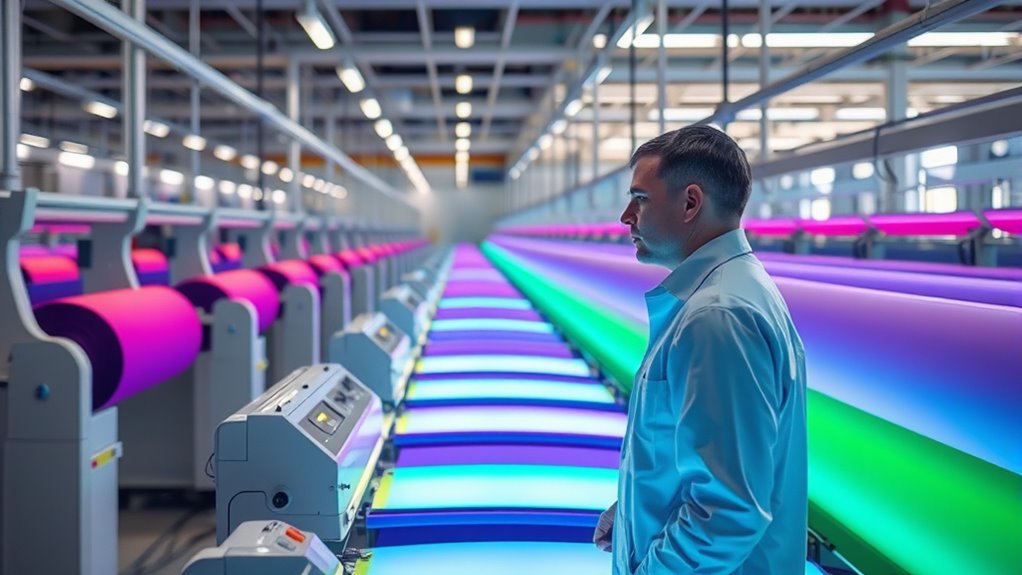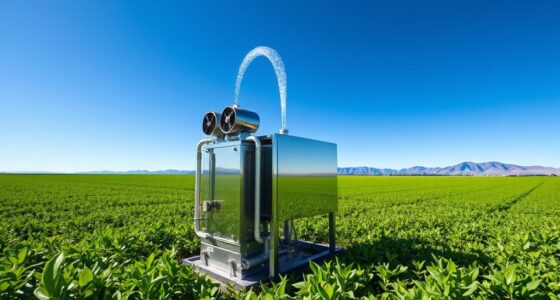Waterless dyeing is revolutionizing the fashion industry by cutting water, chemicals, and energy use during textile coloring. It employs innovative techniques like supercritical CO2 and eco-friendly dyes, enabling brands to create vibrant, sustainable products. This shift helps reduce environmental impact, lowers costs, and boosts brand reputation. If you want to understand how these advancements are shaping eco-conscious fashion’s future, there’s much more to discover.
Key Takeaways
- Waterless dyeing significantly reduces water, chemical, and energy use, lowering environmental impact in fashion manufacturing.
- Advanced technologies like supercritical CO2 and solvent-based dyes enable vibrant colors with minimal water.
- Industry leaders are adopting waterless methods to improve sustainability, cut costs, and enhance brand reputation.
- Challenges such as higher equipment costs and limited color options are driving innovation for scalable solutions.
- Consumer demand for eco-friendly products accelerates adoption, promoting a sustainable revolution in the fashion industry.
The Environmental Impact of Traditional Fabric Dyeing

Traditional fabric dyeing considerably harms the environment because it relies heavily on large amounts of water, chemicals, and energy. During the dyeing process, fabrics absorb dyes through immersion, which often results in excessive water use and dye runoff. This runoff contains hazardous chemicals that pollute rivers and groundwater, harming ecosystems and communities. Additionally, the energy required to heat water and operate dyeing machinery adds to carbon emissions. The dyeing process also generates wastewater that is difficult to treat, leading to environmental contamination. Because of fabric absorption, dyes can be difficult to fully fix onto textiles, causing further waste and pollution. Overall, traditional dyeing methods contribute markedly to environmental degradation, making it vital to seek more sustainable alternatives. Waterless dyeing technology offers a promising solution by significantly reducing water consumption and minimizing chemical waste in the industry.
How Waterless Dyeing Works: Technologies and Methods

Waterless dyeing technologies use innovative methods to color fabrics without relying on large amounts of water. They leverage advanced dyeing chemistry to guarantee vibrant color while reducing environmental impact. These methods focus on controlling fabric absorption, allowing dyes to bond directly with fibers in a closed-loop system. Here are four key ways they work:
Waterless dyeing uses innovative chemistry to deliver vibrant colors with minimal environmental impact.
- Dye Sublimation: Dyes turn into gas and embed into fabric fibers, bypassing water entirely.
- Solvent-Based Dyes: Use eco-friendly solvents that dissolve dyes, reducing water use.
- Air-Dyeing: Employs air to carry dye particles, avoiding water absorption.
- Supercritical CO2: Uses supercritical carbon dioxide as a solvent, offering deep fabric penetration without water. Understanding sustainable practices can help further reduce the environmental footprint of fashion manufacturing.
Benefits of Waterless Dyeing for Brands and Consumers
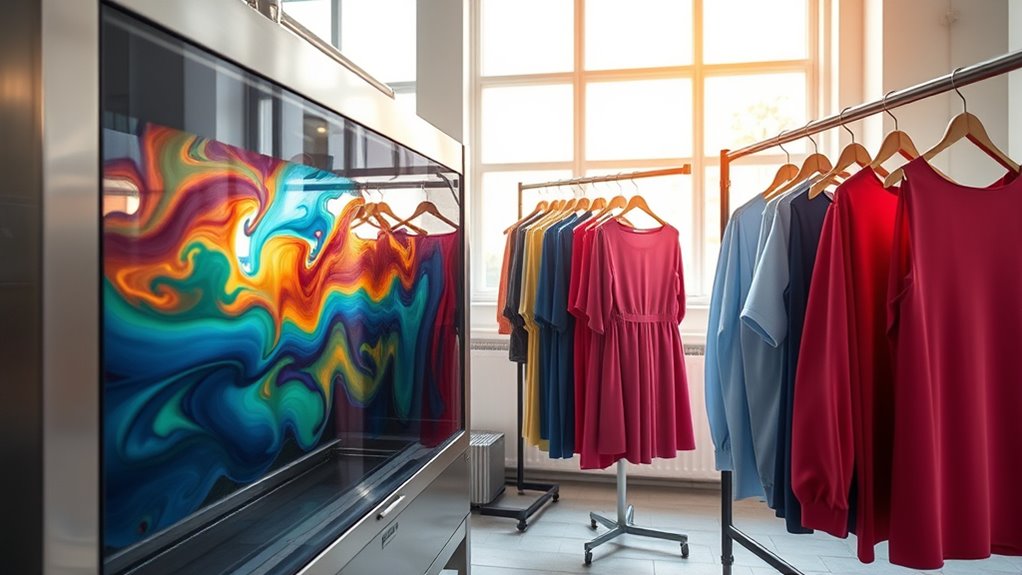
Waterless dyeing considerably reduces environmental impact by cutting water use and pollution. It also lowers production costs, helping brands save money. As a consumer, you benefit from more sustainable products that are better for the planet. Additionally, innovations like glycolic acid exfoliation demonstrate how advanced skincare ingredients can promote healthier skin while supporting eco-friendly practices.
Environmental Impact Reduction
Implementing waterless dyeing considerably reduces environmental impact, offering benefits that resonate with both brands and consumers. This dyeing innovation minimizes water usage, cuts chemical runoff, and lowers carbon emissions, supporting eco friendly practices. By adopting these dyeing innovations, you contribute to a healthier planet and promote sustainability. The positive impact includes:
- Preserving precious water resources for communities and ecosystems.
- Reducing pollution from harmful chemicals entering waterways.
- Lowering greenhouse gas emissions associated with traditional dyeing processes.
- Enhancing brand reputation as environmentally responsible, appealing to conscious consumers.
- The use of advanced dyeing technologies also improves color accuracy, leading to more vibrant and consistent product outcomes.
With waterless dyeing, you’re part of a movement that makes fashion more sustainable, helping protect the environment for future generations while aligning with your eco-conscious values.
Cost-Effective Production
By adopting waterless dyeing, brands can substantially cut production costs while maintaining high-quality results. This method reduces expenses related to water, energy, and chemicals, leading to significant cost savings. Additionally, waterless dyeing simplifies the supply chain by minimizing the need for extensive water treatment and waste management processes. As a result, you can streamline production schedules and reduce delays caused by resource shortages or environmental compliance issues. The overall efficiency gain translates into lower manufacturing costs, which can be passed on to consumers through more affordable prices. Furthermore, the reduced dependency on complex supply chain logistics enhances your ability to meet market demands quickly. Incorporating sustainable practices like eco-friendly dyeing methods not only benefits the environment but also appeals to increasingly conscious consumers. Ultimately, waterless dyeing offers a strategic advantage for brands aiming to balance profitability with sustainability.
Challenges and Limitations of Waterless Dyeing Techniques
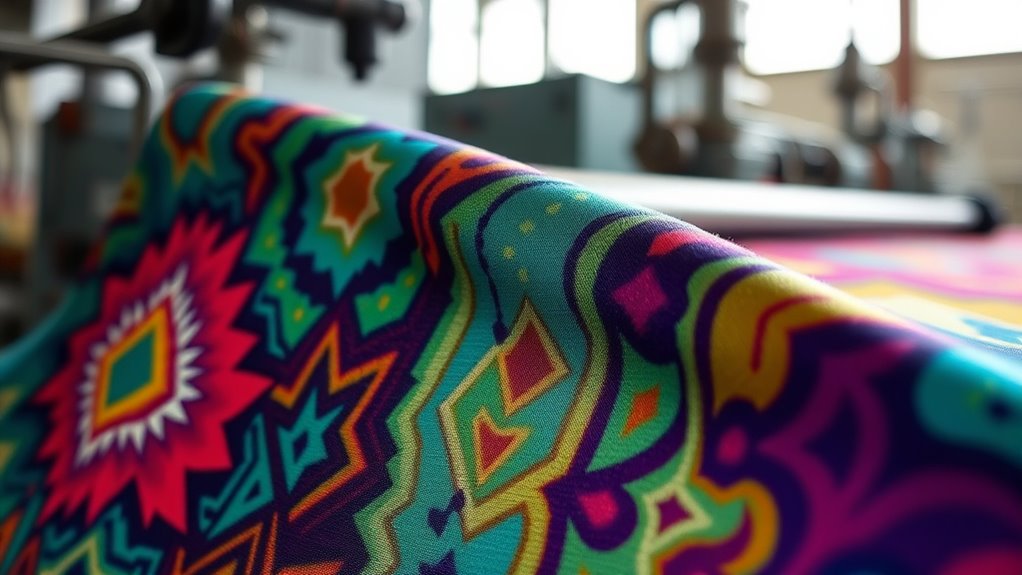
Waterless dyeing techniques face some significant hurdles that you should consider. You might find the color options are limited, and the initial equipment costs can be high. Additionally, scaling up production often presents challenges that could affect overall efficiency. Moreover, ongoing research into sustainable methods like sound healing science could inspire innovative solutions to these limitations.
Limited Color Range Options
Have you ever wondered why waterless dyeing methods often offer fewer color options? It’s because the technology limits the size of the color palette and dye variety available to manufacturers. This restriction can leave you feeling disappointed if you’re seeking vibrant, diverse designs. The challenges include:
- Restricted shades that can make your designs seem dull or repetitive
- Limited ability to match specific hues, reducing customization options
- Fewer options for complex color blending, impacting creativity
- A narrower dye palette that can leave your wardrobe feeling monotonous
While waterless dyeing reduces environmental impact, it often sacrifices the richness of color variety. This limitation can make you crave more vibrant, expressive clothing options that reflect your unique style.
High Equipment Costs
Implementing waterless dyeing technology requires significant upfront investment in specialized equipment, which can be a major hurdle for many manufacturers. The high equipment costs create a substantial cost barrier that deters smaller companies from adopting this eco-friendly method. These advanced machines often come with hefty price tags, making the initial equipment investment a critical consideration. While the long-term savings on water and chemicals are appealing, the immediate financial burden can be prohibitive. This limits widespread adoption, especially among manufacturers operating on tight budgets. Overcoming this challenge involves weighing the long-term environmental benefits against the substantial upfront costs. Until equipment costs decrease or financing options improve, high equipment investment remains a key limitation of waterless dyeing techniques. Vertical storage solutions can also help manufacturers optimize existing space and reduce overall costs during implementation.
Scaling Production Challenges
Scaling production with waterless dyeing methods presents significant challenges, as the specialized equipment is often designed for smaller batches rather than large-scale manufacturing. You might feel frustrated trying to meet demand while maintaining quality and sustainability. These hurdles can slow down your manufacturing efficiency and limit growth.
Consider these key issues:
- Limited equipment capacity restricts mass production, risking delays.
- High initial investment strains budgets, making expansion difficult.
- Process consistency becomes harder at larger volumes, affecting quality.
- Supply chain complexities increase, complicating scaling efforts.
Overcoming these obstacles requires innovation and strategic planning, but the potential benefits—sustainable growth and eco-friendly production—make it worth the effort.
Leading Companies Pioneering Waterless Dyeing Solutions

Leading companies in waterless dyeing are transforming the textile industry by developing innovative solutions that substantially reduce water consumption and environmental impact. These pioneers leverage advances in textile chemistry to create sustainable dyeing dyes that require no water during the process. Brands like DyeCure and ColorZen are leading the way, utilizing proprietary chemistry to achieve vibrant, long-lasting colors without traditional water-based methods. Their focus on eco-friendly dyeing dyes minimizes chemical waste and energy use, aligning with global sustainability goals. By investing heavily in research and development, these companies are pushing the boundaries of textile chemistry, creating efficient, eco-conscious solutions. Their innovations are setting new standards, encouraging others in the industry to adopt waterless dyeing techniques that protect water resources and reduce pollution. sustainable dyeing dyes are a key component in advancing eco-friendly textile manufacturing.
Case Studies: Successful Adoption of Waterless Dyeing in Fashion
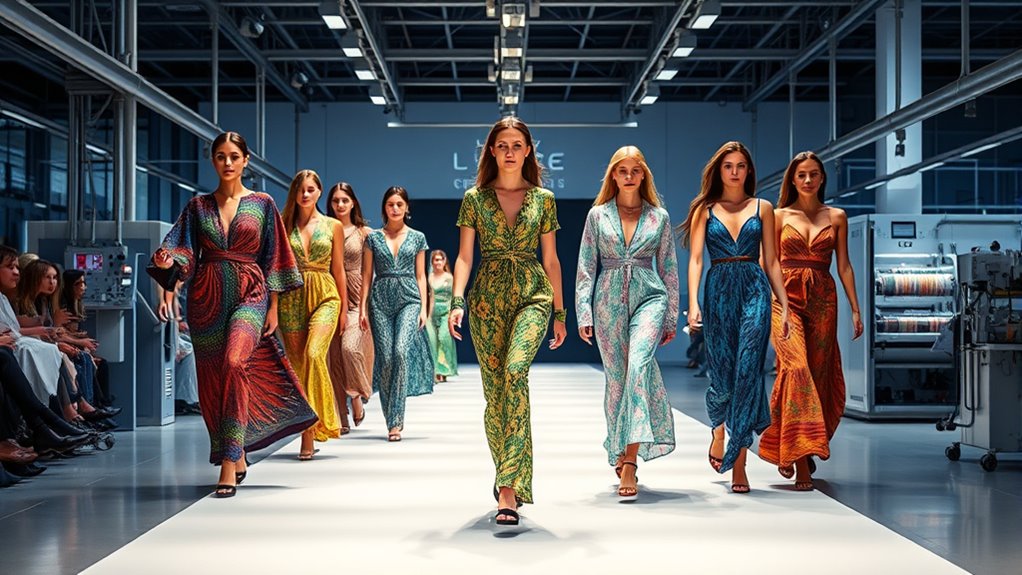
Many fashion brands are now successfully adopting waterless dyeing techniques, demonstrating that sustainability and profitability can go hand in hand. These case studies showcase how dyeing alternatives boost fabric sustainability while reducing environmental impact. When brands embrace waterless dyeing, they often experience:
- Cost savings through reduced water and energy use
- Enhanced brand reputation by committing to eco-friendly practices
- Innovative designs made possible by new dyeing processes
- Market differentiation that appeals to eco-conscious consumers
- Adoption of sustainable payment solutions to align their entire business operations with eco-friendly initiatives, further strengthening their commitment to sustainability.
These successes prove that sustainable fabric coloring isn’t just a trend but a viable, profitable strategy. By adopting waterless dyeing, you can align your brand with future-focused dyeing alternatives, ensuring a positive environmental impact while maintaining quality and style.
Future Trends and Innovations in Sustainable Fabric Coloring

As technology advances, sustainable fabric coloring is poised to undergo significant innovations that will reshape the industry. One key trend is the increased use of biodegradable fibers, which require eco-friendly dyeing methods to minimize environmental impact. Researchers are developing dyes that bond effectively with these fibers, enhancing durability while maintaining sustainability. Additionally, dyeing automation is set to revolutionize the process, increasing precision and reducing waste. Automated systems can optimize dye application, ensuring consistent color quality with minimal water and energy use. Future innovations may also include smart dyes that change color with environmental conditions, further reducing the need for multiple dyeing steps. These advancements will make sustainable fabric coloring more efficient, scalable, and better aligned with global efforts to reduce fashion’s ecological footprint.
Consumer Awareness and the Shift Toward Eco-Friendly Fashion
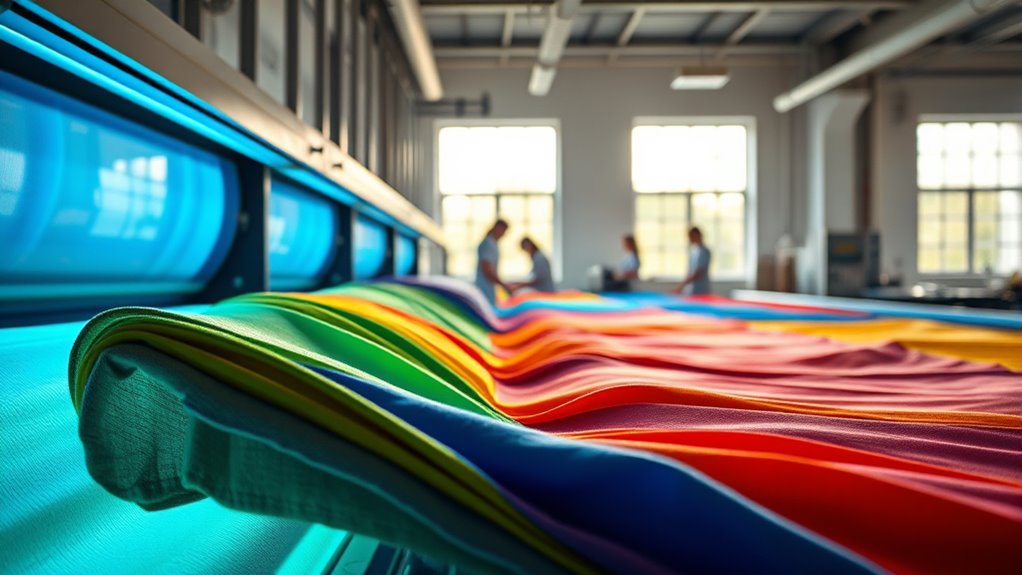
Consumers are increasingly aware of the environmental impact of their fashion choices, driving a shift toward eco-friendly apparel. This awareness stems from better consumer education, making you more conscious of how your wardrobe affects the planet. Your eco conscious choices matter, encouraging brands to adopt sustainable practices like waterless dyeing.
Consider these powerful impacts:
- You influence brands to prioritize eco-friendly materials.
- Your purchasing decisions promote sustainable innovation.
- You help reduce water wastage and chemical pollution.
- Your awareness inspires others to follow suit.
Policy and Industry Standards Promoting Waterless Dyeing Adoption
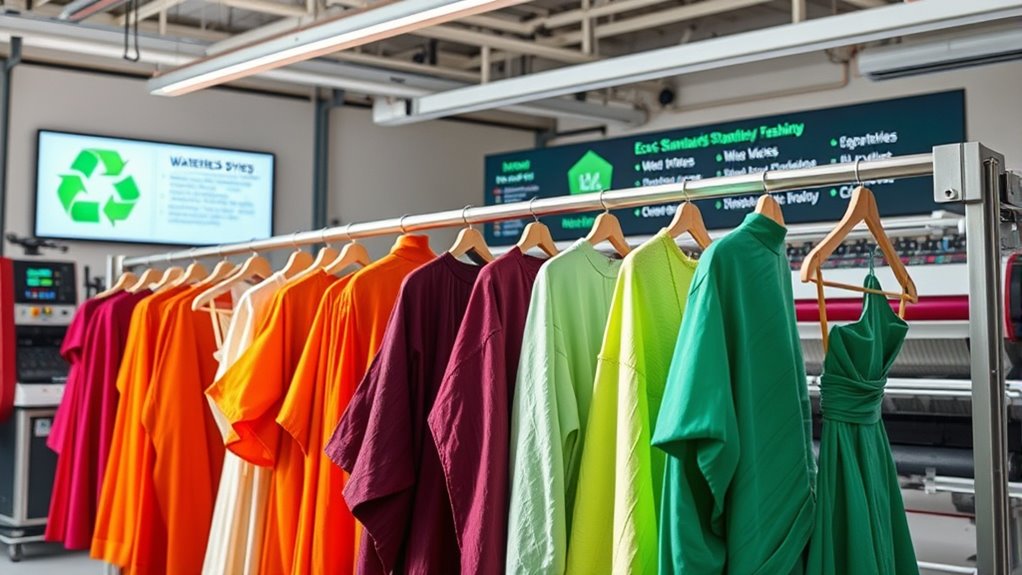
Policy frameworks and industry standards are increasingly shaping the adoption of waterless dyeing techniques across the fashion sector. Governments and regulatory bodies emphasize regulatory compliance to reduce environmental impacts, encouraging brands to adopt sustainable practices. Industry certifications, such as eco-labels and sustainability standards, validate companies’ commitment to waterless dyeing, making it easier for consumers to identify eco-friendly options. These standards often set clear benchmarks, pushing brands to innovate and meet stricter environmental criteria. As a result, industry leaders prioritize waterless dyeing to stay ahead of regulations and earn credible certifications. This evolving landscape creates a competitive edge for brands that proactively embrace waterless dyeing, fostering widespread industry shift towards more sustainable, compliant, and certified production methods.
Frequently Asked Questions
What Are the Cost Implications for Brands Switching to Waterless Dyeing?
Switching to waterless dyeing involves upfront investment costs, but you can realize significant long-term cost savings. While you’ll spend more initially on new equipment and training, you’ll reduce water, energy, and chemical expenses over time. These savings not only lower your environmental impact but also improve your brand’s sustainability image. So, though the shift requires investment, it ultimately benefits your bottom line and aligns with eco-conscious consumer preferences.
How Does Waterless Dyeing Affect Fabric Quality and Color Durability?
You’ll find that waterless dyeing enhances fabric texture, making it feel softer and more comfortable. It also maintains excellent color fastness, so your garments stay vibrant longer without fading. Since waterless dyeing uses fewer chemicals and less water, it reduces environmental impact while preserving the fabric’s quality. Overall, this technology guarantees your clothing remains durable and retains its original look, offering a high-quality experience with better sustainability.
Are There Any Health Risks Associated With Waterless Dyeing Chemicals?
Like Pandora’s box, waterless dyeing chemicals raise questions about chemical safety and exposure risks. You might wonder if these chemicals pose health dangers, but manufacturers carefully evaluate them for toxicity and safety standards. While no process is entirely risk-free, waterless dyeing aims to minimize hazardous chemical use, reducing potential health risks. Staying informed and choosing brands committed to safety helps protect you from possible exposure risks.
How Scalable Are Waterless Dyeing Technologies for Mass Production?
You might wonder how scalable waterless dyeing technologies are for mass production. While scaling challenges exist, technological innovations are making it increasingly feasible. You can expect advancements that improve efficiency and reduce costs, enabling larger-scale implementation. As these innovations continue, you’ll find waterless dyeing becoming more practical for widespread use, helping the industry adopt sustainable practices without sacrificing production volume.
What Training Is Required for Workers to Implement Waterless Dyeing Methods?
Think of implementing waterless dyeing as mastering a new dance. You’ll need technical training to learn the steps and certification programs to prove your expertise. This specialized instruction guarantees workers understand the unique processes involved. With proper training, you’ll confidently navigate eco-friendly techniques, making a positive impact on sustainability. So, investing in these programs helps you stay ahead in the industry, turning innovation into an everyday skill.
Conclusion
By choosing waterless dyeing, you help reduce environmental harm, conserve precious resources, and support innovative solutions. You can wear fashion that’s stylish, sustainable, and responsible. You can champion change, embrace eco-friendly practices, and influence industry standards. Together, you and the fashion industry can transform manufacturing, inspire innovation, and create a greener future. Because when you make mindful choices, you help craft a world where beauty, sustainability, and progress go hand in hand.

